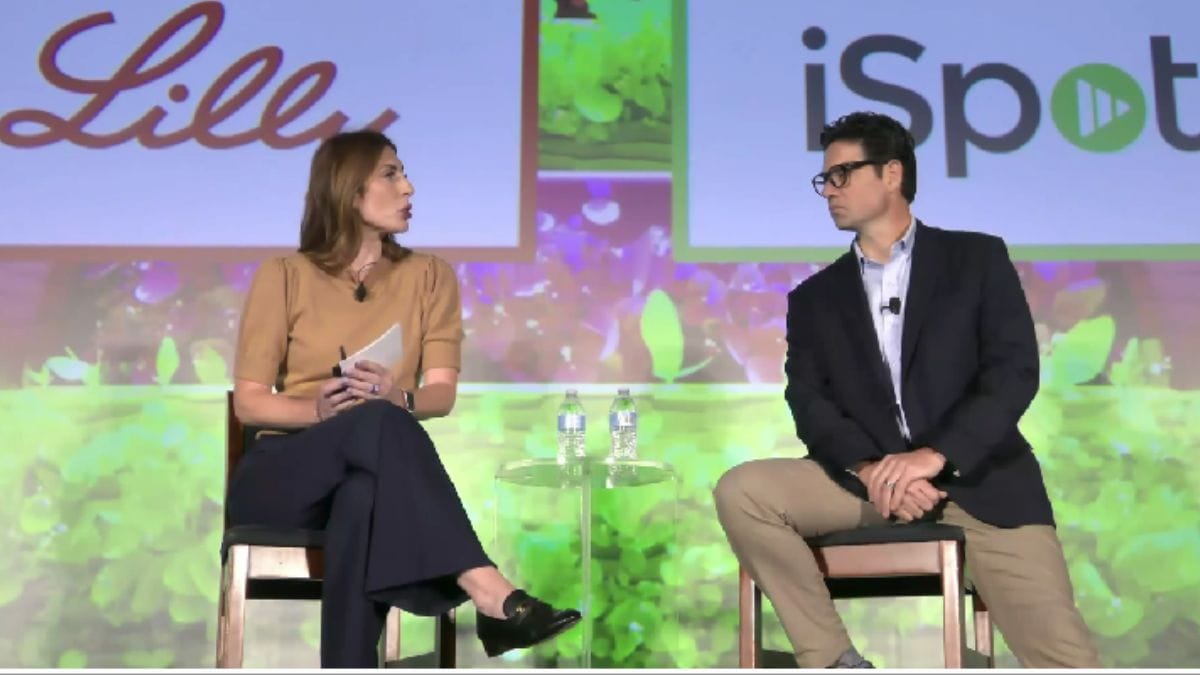|
We spent some time this week listening to presentations at the ANA's Measurement and Analytics Conference. Measurement and data is crucial to marketers and it was impressive to see the smart people involved in measurement and the systems they've created. We cover a few of the ANA sessions in this newsletter, along with some other industry news and research. Enjoy.  Whitney Teplitzky, senior director of customer success at iSpot, and Zachary Schroll, AVP of consumer analytics at Eli Lilly (JL Photo) "We need to make sure that we have the right measurement partners and solutions available to make good strategic decisions," said Zachary Schroll, AVP of consumer analytics at Eli LillyLike other industries, the pharmaceutical business is navigating the shift of viewers from linear TV to streaming. Traditionally pharma companies have been big spenders in linear because they’re constantly rolling out new drugs and need to reach a broad swath of consumers quickly. In the current media environment, pharma marketers need to know that if they shift their spending to streaming, will they continue to get the lift they need. That makes measurement important. At the Association of National Advertisers’ Measurement and Analytics Conference in Chicago Wednesday, pharma company Eli Lilly talked about how unified measurement from one of its partners, iSpot, helps ensure its reaching the consumers it needs to reach across both linear and digital. [Read More] Streaming is gaining popularity across diverse audiences, according to a new Inclusive Screen Report from LG Ad Solutions. The ability of CTV to deliver personalized viewing and advertising experiences contributed to Black, Hispanic, Asian and LGBTQ+ viewers preferring it to linear, LG said. Many of the preferences lined up for all of the groups studied. Among Black audiences, 64% preferred streaming over traditional TV. The same percentage (64%) of Asian viewers preferred streaming, as did 63% of Hispanic viewers. Among LGBTQ+ viewers, 57% chose streaming. Similarly, when asked if they preferred free ad-supported streaming to ad-free subscription services, each group preferred free and the percentages were closely grouped between 74% for LGBTQ+ and 68% for Hispanics. [Read More] Reach and frequency have long been the bedrock of media planning and buying. As media has fragmented and mass media has given way to digital, cross-media measurement has become the holy grail. Marketers, always worried about how much of their ad spending is being wasted, are now concerned that they are getting too much frequency and not enough reach. To solve this vexing problem, the Association of National Advertisers has set about building its own cross-media measurement solution, Aquila. At the ANA’s Measurement and Analytics Conference in Chicago on Tuesday, attendees got an update on Aquila’s progress during a panel discussion moderated by Joe Mandese of MediaPost. ANA Group VP Bill Tucker said that Aquila has begun trials with over 20 major advertisers and that campaign data will be running through its pipes through the end of the year. [Read More] At the Association of National Advertisers’ Measurement and Analytics Conference in Chicago Monday, executives from Comscore and The Trade Desk talked about how expanded data and programmatic technology could increase spending on digital audio and podcasts while boosting the effectiveness of ad campaigns. It seems like everyone has a podcast and everyone is listening to and talking about their favorite podcasts. As most listeners will tell you, they’re already hearing a bunch of ads even before the show starts. The data show there is indeed a massive amount of listening going on when it comes to digital audio, said Jessica Trainor, head of partnerships at Proximic by Comscore. Two out of three American consumers are touching digital audio today, Trainor said, pointing to statistics that 34% listen to podcasts weekly, up 5.5%, and 75% stream music, up 5%. Smart speaker penetration is up to 38 million households. [Read More] Live events–especially sports—are the final frontier for streaming as it takes over the television business. Amagi, whose pipes power more than half of the free ad-supported streaming TV (FAST) business in the U.S., surveyed 500 consumers for its recent Global FAST Report. Live is the premium programming that FAST channels have lacked. For consumers live events become the kind of appointment viewing that drives demand for streaming services, not to mention advertiser interest. “Over the last five years, we’ve seen numerous articles and discussions written about the 'Streaming Wars' between the major streaming services, and there still isn’t a consensus on who won and who lost. But you could make an argument that live programming is the last battle to be won,” according to the Amagi report, titled The Power of Live Programming: a Catalyst for Streaming Success, said. [Read More] ALSO WORTH READINGVerizon Leads as NFL's Most-Seen Week 1 Advertiser (The Measure) These Sports Sponsors Are Scoring With Fans (The Measure) What Motivates People to Try Up-And-Coming Brands? (The Measure) Comscore's Smriti Sharma On Why AI Tool Usage Is the Next Big Thing (TVRev)
|